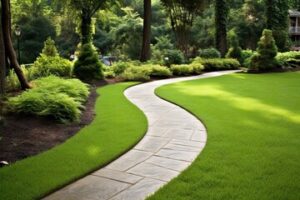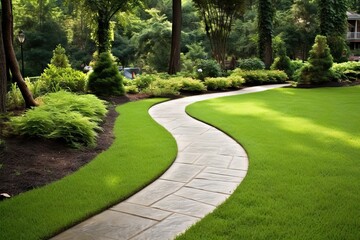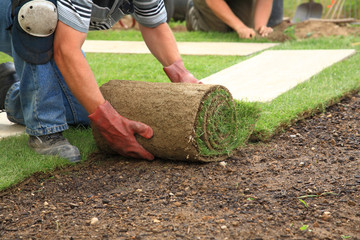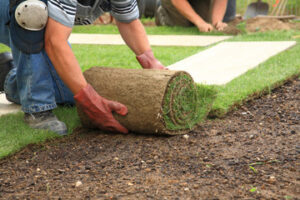A well-maintained lawn is not only attractive, but it also adds value to your property. A healthy lawn helps control erosion, absorbs and breaks down organic chemicals, improves flood control and creates a cooling effect on hot days.

Get on a maintenance schedule. Mow regularly and fertilize in the spring and fall to support healthy grass growth. Contact Prime Cut Lawn and Landscaping for professional help.
When it comes to lawn and landscaping design, the goal is to create a beautiful and functional outdoor space that suits your property’s unique conditions. The design process incorporates elements like planting beds, water features, and walkways to create a cohesive landscape plan that is tailored to your lawn’s needs.
A great way to get started with landscaping is by defining garden beds, which make it easier for you to manage your plants. You can start by mulching your beds or edging them to create a clean and polished look. You can also add annuals and perennials to add bursts of color throughout your yard.
Another important aspect of designing a garden is scale and pacing, which help your yard feel balanced and pulled together. You’ll want to keep in mind the mature size of your plants when planning a garden, and you’ll want to provide adequate space for them to grow.
It’s also important to think about how your landscape will evolve over time. Regular lawn mowing and trimming helps control the spread of grass diseases, and proper drainage can reduce erosion and prevent flooding. Incorporating rainscaping — using natural methods to retain and reuse rainwater — is an eco-conscious approach to improving local water quality.
Finally, it’s a good idea to choose materials and colors that complement your home, and fit in with your neighborhood’s style. For example, you might want to choose materials that reflect the historic architecture of your house, or you might prefer to use traditional plant and tree species. You can also opt for a unified design theme to tie the different parts of your yard together. If you’re not sure where to start, a landscape consultation can help you find your vision.
Installation
Having a lush lawn enhances the aesthetic of your property and improves its value. However, there are many factors that influence the costs and timeline of a lawn installation project. A thorough understanding of these factors can help you plan your budget and expectations.
Professionals can provide a variety of landscaping services to meet your needs. These include design, planting, mulching, and retaining walls. They can also install or repair patios, walkways, and driveways. If you are planning a major landscaping project, consider working with professionals who offer these services to streamline the process and ensure that all your desired elements are included in the final design.
Landscapers can help you choose the right grass type and installation method for your specific yard. They can also perform a soil test to determine the nutrient levels and pH balance of your soil. Based on this information, they will recommend the best grass species and install it according to local conditions.
There are several options for establishing a new lawn, including hand seeding, hydroseeding, and sodding. Each has advantages and disadvantages. Hand seeding is cost-effective but may take longer to establish a full lawn. Hydroseeding is quicker but may require a higher level of maintenance. Sodding is costly but can be quick to establish a mature lawn.
Before starting your installation project, consult a local utility company to have the lines marked before you begin digging. This will prevent you from accidentally breaking a gas or water line and causing costly damage to your property.
Once the landscaping is finished, regular lawn care will keep it healthy and vibrant. Watering, fertilizing, weed control measures, and insect control are essential for maintaining a well-kept garden. In addition, aerating the lawn regularly relieves soil compaction and encourages root growth. Regular mulching helps retain moisture and suppresses weed growth. A balanced fertilizer should be applied every 6-8 weeks during the growing season.
Maintenance
A lush lawn reflects a well-cared for property and adds significant value to a home. However, achieving one requires much more than just mowing and trimming. Lawn care specialists focus on the health of soil and turf, weed management and disease prevention to create and maintain a thriving yard.
The right fertilization and watering regimen, as well as annual de-thatching and aerating, help grass to resist disease, weeds and drought. The way in which a lawn is mowed and the height at which it is cut can also influence its overall health and appearance.
Integrated landscape and lawn maintenance services keep properties looking beautiful and well-cared for year round. A lawn care specialist will assess your property and determine the right routine for you. They will help you achieve the look that you desire for your garden, based on your time and budget.
Regular mowing, edging, and trimming create a clean, manicured appearance for your garden. A professional will use a power or manual weeder to remove unwanted weeds and shrubs. Mulching, grading and drainage, pruning, bed weeding, plant replacements, seasonal planting, raking debris, and leaf removal are additional services that your lawn and garden need to stay looking its best.
Weeds are a common problem in many lawns, and their presence is often a sign that the soil and grass have been neglected. Combined with improved maintenance practices, the application of a pre-emergent or post-emergent herbicide can provide effective weed control.
As part of regular maintenance, composting grass clippings and leaves returns valuable nutrients to the soil and reduces the need for synthetic chemicals. Organic lawn treatments and fertilizers are available for environmentally conscious homeowners, derived from natural sources that don’t pollute the environment.
Annual spring and autumn lawn care is vital for a healthy, vibrant lawn. Aerating the soil helps to reduce compaction and improves drainage. Overseeding new lawns or spots that need refreshing can be done in mid-October in milder climates and as early as mid-February in colder areas. Regular pruning of groundcover, roses and fruit trees keeps them strong and free of dead wood.
Integrated Landscaping
The increasing recognition that sectorial approaches to land management are not sufficient for meeting global challenges has led to the adoption of “landscape approaches” as a way to balance food production, poverty alleviation and biodiversity conservation. Yet there is a lack of agreement on how to define and characterize landscape approaches, which has resulted in a plethora of interlinked terminology and re-invention of ideas and practices under different guises.
To address this gap, this protocol describes a systematic mapping process that seeks to map and categorize existing literature on integrated landscape initiatives for agriculture, development and conservation (ILIAC). This will help to chart the evolution of landscape approach theory and consolidate and synthesize existing definitions. It will also help identify gaps in knowledge and provide a basis for identifying where further research is needed to support the implementation of ILIAC. This work builds on previous mapping efforts by the 1000L initiative and other LP initiatives.



